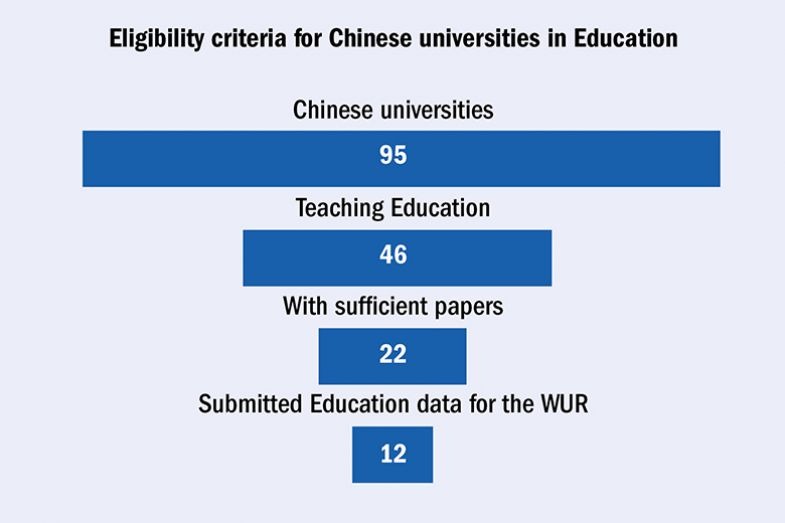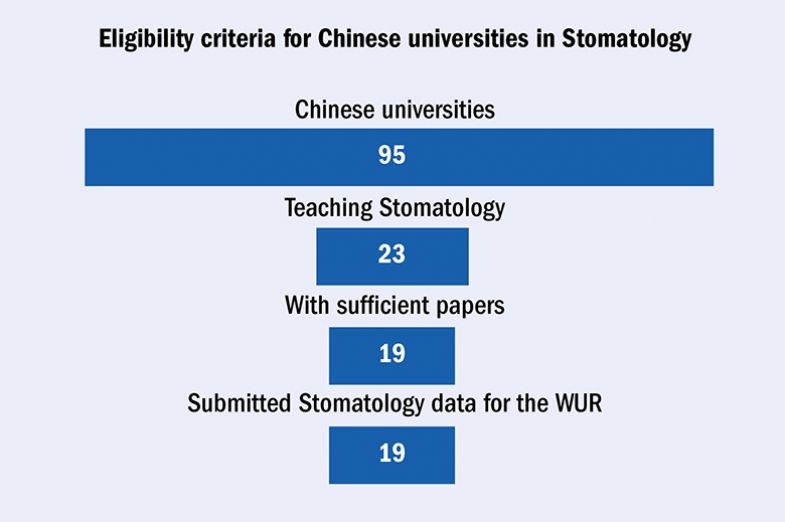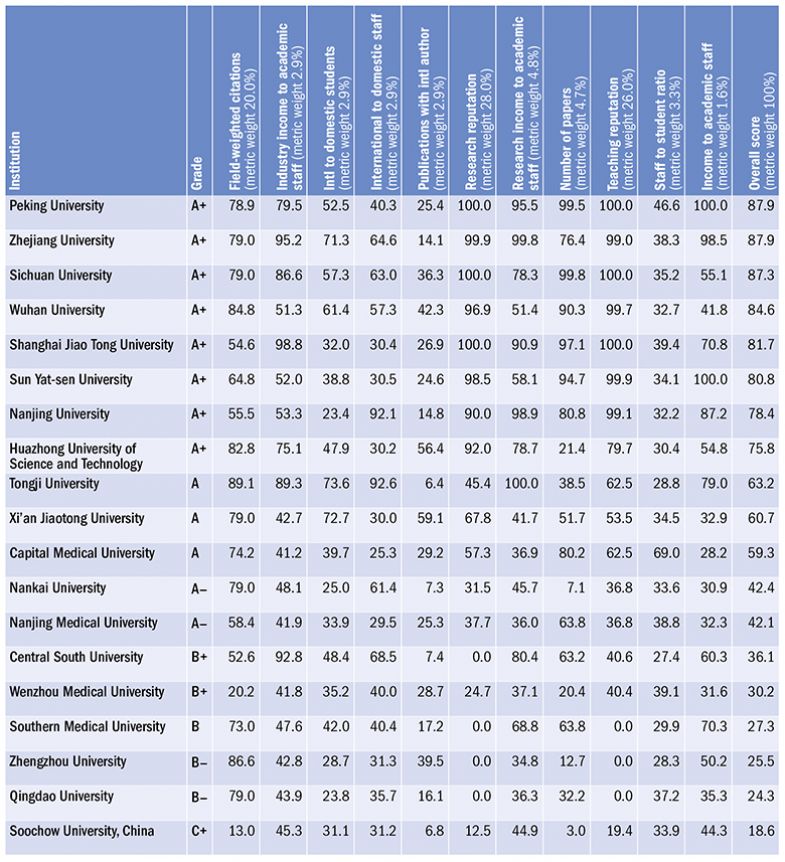Browse the full results of the China Subject Ratings 2023
The Times Higher Education China Subject Ratings are the only performance tables that judge Chinese institutions against their global peers based on the Chinese Ministry of Education’s classification of subjects. The ratings measure research-intensive universities across all their core missions: teaching, research, international outlook and knowledge transfer. We use 11 carefully calibrated performance indicators, listed below, to provide the most comprehensive and balanced comparisons, trusted by students, academics, university leaders, industry and governments. With 83 subjects included, the ratings provide grades across more subjects than any other major rankings or ratings provider.
The performance indicators are grouped into five areas: teaching (the learning environment); research (volume, income and reputation); citations (research influence); international outlook (staff, students and research); and industry income (knowledge transfer).
The data used for the THE China Subject Ratings 2023 are drawn from the THE World University Rankings (WUR) 2023, the THE China Reputation Survey 2022 and 2023, the THE Academic Reputation Survey 2021 and 2022, and Elsevier bibliometrics. We have published 13 pillar-level ratings, which measure performance against 83 subjects in total. We have also published an overall table that provides an overview of how institutions have performed across the different areas.
The metrics
Teaching (the learning environment)
- Reputation survey (teaching)
- Academic staff-to-student ratio
- Institutional income per academic staff member
Research (volume, income and reputation)
- Reputation survey (research)
- Research income per academic staff
- Publications
Citations (research influence)
- Field-weighted citation impact
International outlook (staff, students and research)
- Proportion of international students
- Proportion of international academic staff
- International co-authorship (proportion of international publications)
Industry income (knowledge transfer)
- Research income from industry and commerce per academic staff
Metric weightings
The metric weightings for each subject are calculated in line with the related subject weightings used in the WUR.
Grade production
Once the overall scores have been produced, a grade is calculated for each university within each subject using a grading system of A+ to C−. These grades are evenly split across the ranked universities across the world, such that the top 11.11 per cent of world universities in a subject receive an A+, the next 11.11 per cent receive an A, and so on.
Reputation survey
A survey was sent to 240,000 published and cited Chinese academics in September 2022. We asked them to nominate the universities in China that they perceive to be the best for teaching and research in their field (they could name up to 10 institutions for teaching and up to 10 in research). This year, the results of the two most recent China Reputation Surveys were incorporated in the ratings.
Each year, we also send an annual survey to a sample of global academics randomly selected by Elsevier, in which we ask them to nominate the universities across the world that they perceive to be the best for teaching and research in their field (they can name up to 15 institutions in each category). We combined the 2021 and 2022 results for use in the ratings.
The reputation survey scores for institutions within China were based on the scores from the global survey combined with a weighted version of the mentions they received in each category for the China-specific survey. Universities outside China were given reputation survey scores based on the global survey only.
Subjects included
China’s Ministry of Education categorises 113 subjects across 14 pillars. The ratings measure performance across 83 of these subjects within 13 pillars. These pillars are:
- Agriculture
- Arts
- Economics
- Education
- Engineering
- History
- Law
- Literature
- Management
- Medical
- Philosophy
- Physical science
- Interdisciplinary
We excluded 15 subjects because they had a strong military and/or national security theme, while seven other subjects were excluded because they were too specific to China and therefore difficult to compare internationally. We also excluded eight subjects because the data quality was not sufficient for international comparisons.
Exclusions
There are four key criteria for universities to be included in the subject ratings:
- They must be included in the WUR 2023
- They must have been eligible for the subject rankings related to the WUR 2023
- Outside China, they must have selected the relevant detailed subject during the WUR 2023 submission. Within China, there must be evidence that they teach the relevant subject
- They must meet a minimum threshold for the number of papers published between 2018 and 2022 for each specific subject.
Universities that meet these four criteria are included in the ratings for a given subject. All institutions that feature in at least one of the subjects are included in the overall table, which is designed to provide an overview of performance across the different subjects.
Subject calculation examples
Education
Of the 95 Chinese universities in the China Subject Ratings, 46 provided evidence that they teach courses in the Education subject as defined by the Ministry of Education. Of these 46 universities, 12 were eligible for a grade based on their having entered data in the World University Rankings for the Education subject, and having a sufficient number of research papers in the years 2017 to 2022. Globally, 648 universities were eligible for a grade.

The grades are awarded based on an underlying score built from the above 11 metrics. For education, the citation score (which is based on the number of citations per published paper) accounts for 29.7 per cent of the overall score. Research reputation and teaching reputation account for 27.7 per cent each. The remaining 14.9 per cent of the score is made up from the other eight metrics.
The following table shows the scores achieved in each metric for the seven Chinese universities that received an A grade:

Focusing on the citation scores based on Elsevier’s bibliometric data, four Chinese universities score above 90: Huazhong University of Science and Technology, Nanjing Normal University, Northeast Normal University and Zhejiang University. Two universities score between 80 and 90: Beijing Normal University and East China Normal University.
In reputation, three universities score above 80 for research reputation, and four for teaching reputation; these universities are clearly highly regarded both within China and in the wider global community of academics within Education.
Multiplying all the scores by their “metric weights” and adding them up gives the overall score for each university. These scores are then ordered against all universities’ Education scores. The top 11.1 per cent receive an A+, the next 11.1 per cent receive an A, and so on.
Two institutions score above 80 in all of the three prominent metrics – Beijing Normal University and Zhejiang University – which, along with their other scores, results in their receiving a grade of A+ for Education. East China Normal University and Peking University also score an A+ as they, too, are in the top 11.1 per cent of scores.
Stomatology (dentistry)
Of the 95 Chinese universities in the China Subject Ratings, 23 provided evidence that they teach courses in the Dentistry subject as defined by the Ministry of Education. Of these 23 universities, 19 were eligible for a grade based on having entered data in the related World University Rankings subject, and having a sufficient number of research papers in the years 2017 to 2022. Globally, 536 universities were eligible for a grade.

For dentistry, the citation score accounts for 20 per cent of the overall score, while research reputation and teaching reputation account for 28 per cent and 26 per cent, respectively.
The overall number of papers accounts for 4.7 per cent of the score, and research income per staff member 4.8 per cent. The remaining 16.5 per cent of the score is made up from the other six metrics.
The following table shows the scores achieved in each metric for the 19 Chinese universities:

Two Chinese universities score above 85 for citations. For reputation, eight universities score 90 or above for research reputation, and seven for teaching reputation.
Multiplying all the scores by their “metric weights” and adding them up gives the overall score for each university. These scores are then ordered against all universities’ dentistry scores. The top 11.1 per cent receive an A+, the next 11.1 per cent receive an A, and so on.
Eight Chinese institutions achieve an A+ grade, while five others achieve an A or A−. The performance of Chinese institutions widely differs across the prominent metrics of citations and reputation in dentistry.
Register to continue
Why register?
- Registration is free and only takes a moment
- Once registered, you can read 3 articles a month
- Sign up for our newsletter
Subscribe
Or subscribe for unlimited access to:
- Unlimited access to news, views, insights & reviews
- Digital editions
- Digital access to THE’s university and college rankings analysis
Already registered or a current subscriber? Login


